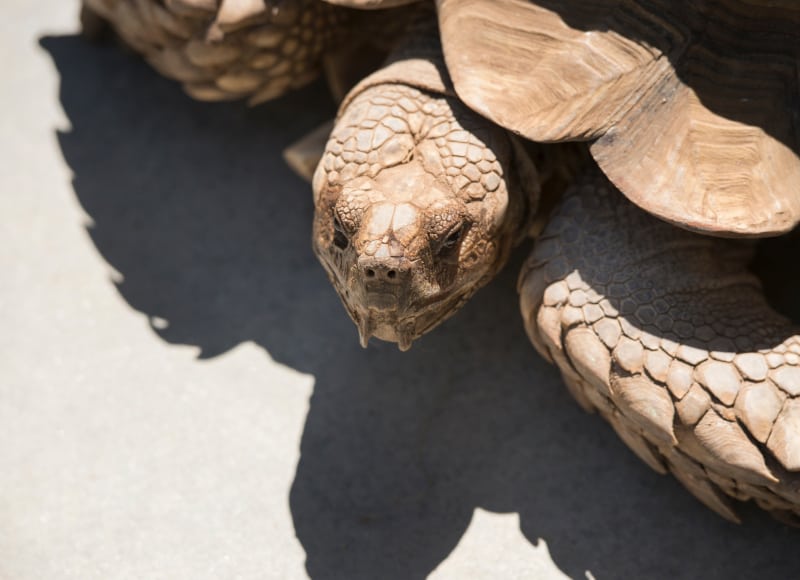Turtles are reptiles that look quite harmless. And even if the chance of being hurt by a turtle is low, it doesn’t change the fact that these cold blooded animals are, by nature, rather dominant and quite often fight with others over almost everything – over habitat dominance, over a mating partner, over food, even over a sun basking spot. Therefore, it goes without saying that turtles are aggressive animals – all things considered.
Nonetheless, their aggressiveness should not be taken as granted all the time. You see, they may get angry quite easily, but it rarely ever happens without a reason. Usually, if your turtle becomes aggressive or even hostile towards you, other human being, or any other animal, then it is the result of some external factor and you just don’t know about it. Just yet.
Well, turtles’ aggressiveness may be a problematic issue, especially if we want to place more than one pet inside the tank. So, what to do in order to solve the issue of aggressiveness? Is there a way to reduce that or even eliminate such a behavior? To help you find the answers, I prepared an article with all the things that I know about turtles’ aggressiveness from my own experience and from what turtle specialists told me.
Why is my turtle aggressive?
So, first of all, let’s start from the things that are of the highest importance. Namely, the reasons behind this behavior. You see, despite the fact that in the wilderness it is possible to find turtles clustered in one place, they are solitary animals. The only reason why there are turtles next to each other is simply because this area is great as a source of sunlight, temperature, access to water, and due to food resources. It means that the company of other turtles is not necessary, to say the least. To be fair, they are even better when alone, so quite often they may stay together, but at the same time they will try to fight off any company if it reaches its local habitat area. Yet, here are the main reasons why a turtle that is kept in captivity may become aggressive:
Stressful situations
If you are a new turtle owner, then it means that you probably spend quite a lot of time with your newly obtained animal. It is surely great that you wish to take care of it and make sure that he or she has got everything there is to give. Still, it may be counterproductive.
You see, overhandling is one of the most common mistakes that new turtle owners make. It basically means that we touch the turtle too much. Besides that, we have to remember that in most cases our unconscious behavior leads to animal stress. One of the best examples is playing music very loud, especially if speakers are set in close proximity to the tank.
Besides that, we should also remember that placing a tank in a place that is quite often “visited” by humans will induce stress just as well. It is surely a bad idea to put a tank near the hallway or near the doors. Think about a corner of a room. Especially think about the room that is not as often visited by you, other house members, or guests.
Wrong temperature
Another thing worth mentioning as far as the reasons behind aggressiveness in turtles is the temperature in the tank. You see, turtles are quite picky as far as the air temperature is concerned. They don’t like when it is too hot or too cold. We have to make sure there is an ideal balance. However, even more important than the air temperature is the temperature of the water. You see, turtles use that in order to cool themselves down. If we don’t provide them with water that is cool enough, they will not be able to sustain the right temperature of their body. This, in turn, will cause a number of health issues.
Another important thing to remember is a heating lamp. Since turtles use water to cool themselves down, they need to have something to warm up later on. Well, this is when the heating lamp finds its use. The appropriate bulb that will provide enough warmth and UVV light is of utmost importance. In that way, your turtle will successfully divide the time between cooling themselves and warming up.
Water temperature should be at the level of 24 and 27 degrees Celsius (which is approximately 75 to 80 degrees Fahrenheit). Obviously, there can be some slight differences, but we should definitely take a closer look at that and not allow for larger discrepancies. Similar situation applies to a basking bulb. Its power should be somewhere between 50 to 150 Watts, and the precise numbers can be easily calculated if we take the basic information regarding the tank and the size of the turtle into account.
Filthy tank
A lot of new turtle owners do not realize how fast turtles can make a mess. Dirty water is a huge problem for the novice because they are not accustomed to how fast turtles get their habitat dirty. As a result, your reptile will try to escape in order to find a place that is cleaner. While doing so, it will most likely become aggressive.
Remember that sometimes your turtle is not the only reason the water in its tank is dirty. Sometimes the water getting dirty too fast is a result of algae, poor water filter, or simply because your tank is shedding some of its skin.
Wrong diet
Quite often people forget that turtles are not accustomed to the same food that we, humans, eat. Therefore, if something is good for our health, it doesn’t necessarily mean that it will benefit our reptiles just as well. For this reason, we should always stick to a dietary plan that people who are professional turtle owners or specialists in the field of turtle feeding recommend.

How to fix the issues to make a turtle less aggressive?
Stop stressing the animal out
Well, first of all make sure you don’t stress the reptile too much. I know that having a new pet is exciting and we wish to spend as much time with it as possible. Nonetheless, staying so close to a turtle and keep picking it up will surely induce stress and result in aggressive behavior towards you or even towards inanimate objects. It is all due to the fact that a turtle will look for ways to reduce the stress and headbutting or ramming objects or animals is one of such methods.
Obviously, if you like listening to music very loudly, make sure the speakers are not in the same room as the tank with your turtle. Better, pick a place that is as distant as possible, because turtles may not be great at hearing high frequency sounds (they can’t hear them at all), but they are much better at low-frequency, bass-like sounds. And it will surely drive them crazy.
Fix the habitat
Obviously, the problem with the habitat is yet another thing that we can do to reduce the aggressiveness of a turtle. Just make sure that you keep the water temperature at the desired level. Another important thing is to make sure that the basking bulb provides our turtle with enough UVB light and warm temperature to level the temperature of the body after a long time in water.
Needless to say, you should also make sure that dirty water in the turtle’s tank is changed even once a week. Even if it looks moderately good, it can be filled with ammonia or other chemical compounds that are dangerous to a reptile. While doing so, you don’t have to get rid of all the water – usually we change 60% of the volume.
Feed it properly
The most important thing as far as the proper diet is concerned is the right balance. You should make sure that there are some fruits and vegetables there. However, that’s not all. Turtles, when in the wild, often eat insects or fish. So, you can feed them dry insects just as well. Obviously, you have to remember about fish, meat, or pellets.
Now you know if turtles are aggressive and how to deal with that problem!
Though it doesn’t seem like it, turtles can really be quite aggressive. It can manifest in the form of ramming and headbutting other turtles or animals, or even inanimate objects. However, they can also be quite aggressive as far as their owners are concerned. Since turtles’ behavior can become a problem, we should, at least to some extent, minimize the reasons for your turtle’s bad behavior.
Therefore, it is highly recommended to make sure that your reptile’s habitat is clean, the temperature is set on the desired level, and the dietary plan is verified with people who know a thing or two about turtle feeding. Besides that, we should also remember that there are some less important reasons for aggressive behavior. Some of them are mating rituals or pregnancy.
Submit your review | |





















